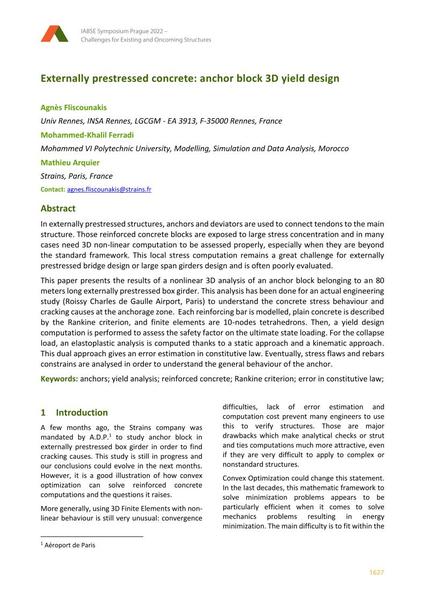Externally prestressed concrete: anchor block 3D yield design

|
|
|||||||||||
Bibliographic Details
| Author(s): |
Agnès Fliscounakis
(Univ Rennes, INSA Rennes, LGCGM - EA 3913, F-35000 Rennes, France)
Mohammed-Khalil Ferradi (Mohammed VI Polytechnic University, Modelling, Simulation and Data Analysis, Morocco) Mathieu Arquier (Strains, Paris, France) |
||||
|---|---|---|---|---|---|
| Medium: | conference paper | ||||
| Language(s): | English | ||||
| Conference: | IABSE Symposium: Challenges for Existing and Oncoming Structures, Prague, Czech Republic, 25-27 May 2022 | ||||
| Published in: | IABSE Symposium Prague 2022 | ||||
|
|||||
| Page(s): | 1627-1634 | ||||
| Total no. of pages: | 8 | ||||
| DOI: | 10.2749/prague.2022.1627 | ||||
| Abstract: |
In externally prestressed structures, anchors and deviators are used to connect tendons to the main structure. Those reinforced concrete blocks are exposed to large stress concentration and in many cases need 3D non-linear computation to be assessed properly, especially when they are beyond the standard framework. This local stress computation remains a great challenge for externally prestressed bridge design or large span girders design and is often poorly evaluated. This paper presents the results of a nonlinear 3D analysis of an anchor block belonging to an 80 meters long externally prestressed box girder. This analysis has been done for an actual engineering study (Roissy Charles de Gaulle Airport, Paris) to understand the concrete stress behaviour and cracking causes at the anchorage zone. Each reinforcing bar is modelled, plain concrete is described by the Rankine criterion, and finite elements are 10-nodes tetrahedrons. Then, a yield design computation is performed to assess the safety factor on the ultimate state loading. For the collapse load, an elastoplastic analysis is computed thanks to a static approach and a kinematic approach. This dual approach gives an error estimation in constitutive law. Eventually, stress flaws and rebars constrains are analysed in order to understand the general behaviour of the anchor. |
||||
| Keywords: |
reinforced concrete anchors yield analysis Rankine criterion error in constitutive law
|
||||
| Copyright: | © 2022 International Association for Bridge and Structural Engineering (IABSE) | ||||
| License: | This creative work is copyrighted material and may not be used without explicit approval by the author and/or copyright owner. |
||||
